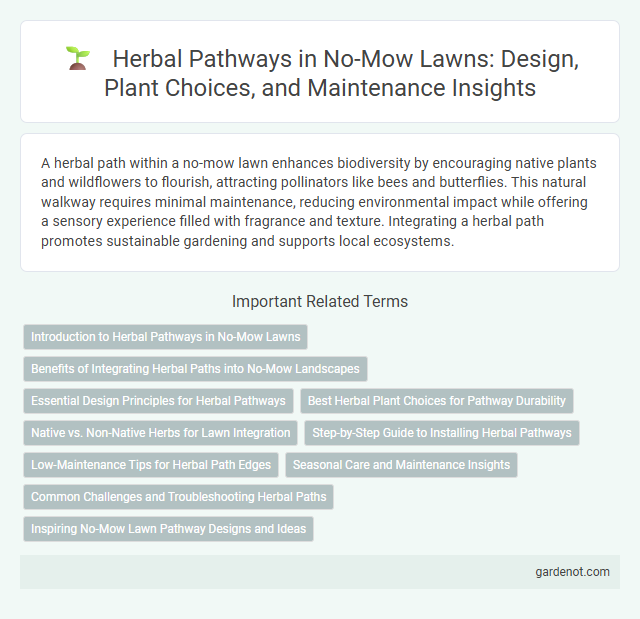A herbal path within a no-mow lawn enhances biodiversity by encouraging native plants and wildflowers to flourish, attracting pollinators like bees and butterflies. This natural walkway requires minimal maintenance, reducing environmental impact while offering a sensory experience filled with fragrance and texture. Integrating a herbal path promotes sustainable gardening and supports local ecosystems.
Introduction to Herbal Pathways in No-Mow Lawns
Herbal pathways in no-mow lawns enhance biodiversity by integrating native herbs and wildflowers that thrive without regular mowing, promoting a resilient ecosystem. These pathways improve soil health through natural nitrogen fixation and support pollinators such as bees and butterflies, crucial for local flora reproduction. Incorporating herbal species like yarrow, clover, and chamomile creates sustainable, low-maintenance green spaces that reduce water consumption and chemical inputs.
Benefits of Integrating Herbal Paths into No-Mow Landscapes
Integrating herbal paths into no-mow landscapes enhances biodiversity by attracting pollinators such as bees and butterflies, promoting ecosystem health without frequent mowing. These aromatic, low-maintenance herbs like thyme and lavender improve soil quality while offering tactile and visual interest throughout the seasons. Herbal paths also provide natural pest control and medicinal benefits, creating sustainable, eco-friendly outdoor spaces that reduce lawn care costs and environmental impact.
Essential Design Principles for Herbal Pathways
Designing herbal paths involves selecting native, drought-resistant plants that promote biodiversity and support pollinators. Paths should be wide enough to allow comfortable access while minimizing soil compaction around delicate herbs, using natural materials like mulch or gravel to maintain permeability. Incorporating layered planting techniques with varied heights enhances aesthetic appeal and ensures year-round greenery in no-mow lawn settings.
Best Herbal Plant Choices for Pathway Durability
Herbal pathways benefit from durable plants like thyme, lavender, and creeping chamomile, which thrive under foot traffic while suppressing weeds and reducing maintenance. These low-growing, drought-tolerant herbs offer aromatic foliage and seasonal blooms that enhance both durability and visual appeal. Selecting hardy herbal species ensures long-lasting, sustainable no-mow lawns with vibrant, resilient pathways.
Native vs. Non-Native Herbs for Lawn Integration
Integrating native herbs into a no-mow lawn supports local biodiversity, promotes soil health, and requires less water and maintenance compared to non-native species. Native plants like Echinacea purpurea and Asclepias tuberosa adapt to regional climate conditions, enhancing ecosystem resilience and providing habitat for pollinators. Non-native herbs may disrupt local ecosystems, often needing more resources and potentially becoming invasive, undermining the sustainability goals of a no-mow lawn.
Step-by-Step Guide to Installing Herbal Pathways
Herbal pathways enhance no-mow lawns by offering low-maintenance, aromatic ground cover that supports biodiversity. Start by selecting native herbs such as thyme, chamomile, and oregano to ensure resilience and seasonal interest. Prepare the soil by removing weeds and loosening the top layer, then plant herb plugs or seeds in well-spaced rows, maintaining consistent moisture until established.
Low-Maintenance Tips for Herbal Path Edges
Herbal path edges thrive with minimal upkeep by choosing drought-tolerant herbs such as thyme, lavender, and rosemary that resist weeds and require less watering. Regularly trimming these herbs encourages dense growth, creating a natural border that reduces soil erosion and limits encroaching grass. Applying organic mulch around the edges retains moisture and suppresses weed growth, enhancing the low-maintenance benefits of an herbal path.
Seasonal Care and Maintenance Insights
Herbal Path no-mow lawns thrive with minimal intervention, requiring seasonal care that emphasizes gentle pruning and selective watering to support native herbs' natural growth cycles. Early spring pruning removes winter residues and promotes fresh shoots, while summer maintenance focuses on hydration during dry spells without overwatering to prevent root rot. Fall preparation involves light trimming and mulching to protect the soil and enhance nutrient retention throughout colder months.
Common Challenges and Troubleshooting Herbal Paths
Herbal paths often face challenges like soil compaction, uneven plant growth, and invasive weeds, which can hinder their aesthetic and ecological benefits. Regular soil aeration and targeted weeding help maintain healthy plant diversity and prevent path degradation. Monitoring moisture levels and selecting drought-tolerant herbal species can address common issues related to inconsistent watering and climate stress.
Inspiring No-Mow Lawn Pathway Designs and Ideas
Herbal pathways create stunning no-mow lawn alternatives by integrating drought-tolerant herbs like thyme, chamomile, and oregano, which thrive with minimal maintenance. These aromatic plants not only reduce the need for mowing but also attract pollinators, enhancing garden biodiversity. Incorporating varied textures and colors within the herbal path design offers an eye-catching, eco-friendly solution that promotes sustainability and enriches outdoor spaces.
Herbal path Infographic

 gardenot.com
gardenot.com